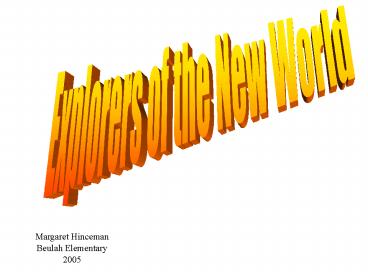Explorers of the New World - PowerPoint PPT Presentation
1 / 34
Title:
Explorers of the New World
Description:
During the Ice Age, the Bering Strait was covered with ice. ... Florida means 'flowery Easter'. Ponce de Leon also searched for the 'Fountain of Youth. ... – PowerPoint PPT presentation
Number of Views:43
Avg rating:3.0/5.0
Title: Explorers of the New World
1
Explorers of the New World
Margaret Hinceman Beulah Elementary 2005
2
During the Ice Age, the Bering Strait was covered
with ice. The Bering Strait is between Asia and
North America.
3
The nomads or wandering people walked across the
ice covered Bering Strait hunting for food.
4
(No Transcript)
5
The earth began to warm and the ice covering
Bering Strait began to melt. As the ice melted,
the nomads could no longer travel across the
Bering Strait. Today, there is a body of water
between Asia and North America.
6
The people followed the large mammoths farther
into the Americas. As the larger animals begin to
die out the nomads were forced to find other food.
7
The wanderers began to hunt smaller animals and
eat berries and nuts. The people no longer
traveled but settled down in one area.
8
Explorers began to wonder if there was land
across the ocean. The Vikings were the first to
make a voyage to the Americas.
9
Eric the Red sailed from Norway to Iceland and
then to Greenland, where he started a colony.
10
The first known voyages by the Vikings.
11
Leif Ericsson, Eric the Reds son landed in North
America in the year 1000.
12
Leif Ericsson sailed from Greenland to Vinland, a
small island off the coast of Canada. Today,
Vinland is called Newfoundland.
13
The Vikings tried several times to settle in
Vinland but the hostile natives and many other
hardships caused them to give up and return to
Greenland.
14
The European Explorers
15
For nearly five hundred years after the Vikings
came to the new world, no new explorers seem to
come. Most of the travels were done over land
until the Europeans began to look for new trade
routes. Bartolomeu Dias and Vasco da Gama made
voyages around Africa trying to reach India. A
young Christopher Columbus from Portugal thought
he knew a better route by crossing the Atlantic.
16
After convincing King Ferdinand and Queen
Isabella of Spain, Columbus sailed across the
Atlantic Ocean to the New World. He took three
ships, the Nina, the Pinta, and the Santa Maria.
17
On October 12, 1492, Columbus sighted land. His
first landfall was in the Bahamas. When he landed
he thought he had reached the Indies in the Far
East and named the natives Indians. He was
unaware he had landed in the New World.
18
The Spanish Explorers
19
Ponce de Leon, a Spanish explorer, sailed to the
New World in search of gold and to conquer new
land.
20
(No Transcript)
21
Ponce de Leon landed at St. Augustine, Florida
and claimed it for Spain. Florida means flowery
Easter.
22
Ponce de Leon also searched for the Fountain of
Youth.
23
Poor maps, poor weather and hostile Indians
created obstacles for Ponce de Leon.
24
The French Explorers
25
Jacques Cartier, a French sailor traveled to the
New World in search of gold and other precious
metals.
26
Jacques Cartier was looking for a northwest
passage to the Far East. He discovered the Gulf
of St. Lawrence and the St. Lawrence River.
27
During his voyage, Jacques Cartier made friends
with the Indians of the Iroquois tribe.
28
The Indians helped Jacques Cartiers sick crew
by giving them a tea made from the white cedar
tree.
29
Jacques Cartier traded with the Iroquois. He
returned to France with furs and two Indian
friends.
30
Jacques Cartier named the St. Lawrence River. He
also named a mountain- Montreal. Today, Montreal
is a city in Canada.
31
The English Explorers
In 1606, Christopher Newport commanded three
ships, the Susan Constant, the Godspeed, and the
Discovery. He set sail to the New World.
32
- Captain Christopher Newport sailed from
England to Jamestown. Newport had three goals - He wanted to discover riches.
- He wanted to find a western sea route to the
continent of Asia. - He also wanted to colonize Virginia.
33
The crew started a colony in Jamestown, Virginia.
The fort kept the settlers safe from the Powhatan
Indians who lived in the area.
34
After several sea voyages, Christopher Newport
opened a store on the James River. People would
come in just to find out news from England.
Today, this area is the city of Newport News.































